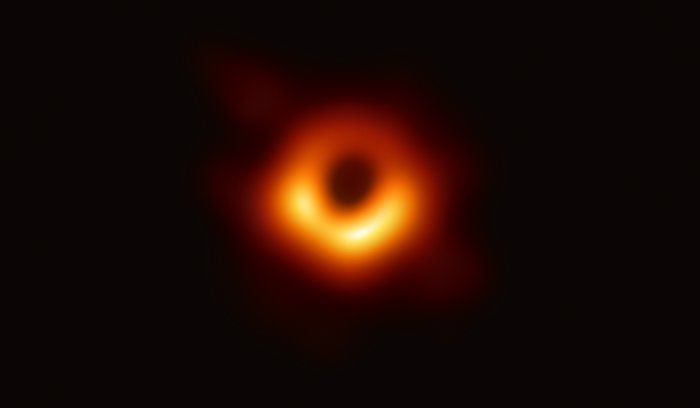Eerste foto van een zwart gat
De Event Horizon Telescope (EHT) – een wereldwijde array van acht radiotelescopen die door internationale samenwerking tot stand is gekomen – is ontworpen om beelden te maken van een zwart gat. Via gecoördineerde persconferenties over de hele wereld hebben onderzoekers van de EHT bekendgemaakt dat ze hun doel hebben bereikt. Ze hebben het eerste directe visuele bewijs van een superzwaar zwart gat en zijn schaduw onthuld in het centrum van Messier 87.
De schaduw van een zwart gat is de dichtste benadering van een foto van het zwarte gat zelf. Aan dat donkere object kan immers geen licht ontsnappen. De grens van het zwarte gat – de waarnemingshorizon waaraan de EHT zijn naam ontleent – is ongeveer 2,5 keer kleiner dan de schaduw die het werpt en heeft een middellijn van iets minder dan 40 miljard kilometer. Dat lijkt misschien groot, maar vanaf de aarde gezien heeft de ring een diameter van slechts ongeveer 40 microboogseconden. Dat komt overeen met de lengte van een creditcard op de afstand van de maan.
Hoewel de radiotelescopen waaruit de EHT bestaat niet rechtstreeks met elkaar in verbinding staan, kunnen de data die zij verzamelen met behulp van atoomklokken – zogeheten waterstofmasers– uiterst nauwkeurig met elkaar worden gesynchroniseerd. Deze waarnemingen werden tijdens een wereldwijde campagne in 2017 op een golflengte van 1,3 millimeter verzameld. Elke telescoop van de EHT produceerde enorme hoeveelheden data – ruwweg 350 terabyte per dag – die werden opgeslagen op snelle, met helium gevulde harde schijven. Deze data werden vervolgens overgevlogen naar speciale supercomputers – zogeheten correlators – van het Max-Planck-Institut für Radioastronomie en het MIT Haystack Observatory om met elkaar te worden gecombineerd. Vervolgens werden ze met baanbrekende rekenmethoden, ontwikkeld door de EHT-samenwerking zelf, zorgvuldig omgezet in een afbeelding.
Credit:EHT Collaboration
Over de afbeelding
| Id: | eso1907a |
| Taal: | nl-be |
| Type: | Observatie |
| Publicatiedatum: | 10 april 2019 15:07 |
| Gerelateerde berichten: | eso2105, eso1907 |
| Gerelateerde mededelingen: | ann19043 |
| Grootte: | 7416 x 4320 px |
Over het object
| Naam: | M87*, Messier 87 |
| Type: | Local Universe : Galaxy : Component : Central Black Hole |
| Constellation: | Virgo |
Image Formats
Coordinates
| Position (RA): | 12 30 49.42 |
| Position (Dec): | 12° 23' 28.04" |
| Field of view: | 0.00 x 0.00 arcminutes |
| Orientation: | North is 0.0° left of vertical |
Kleuren & filters
| Band | Golflengte | Telescoop |
|---|---|---|
| Millimeter | 1.3 mm | Event Horizon Telescope |

